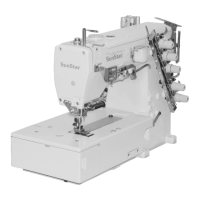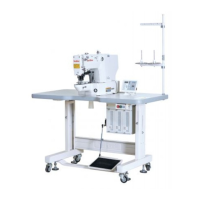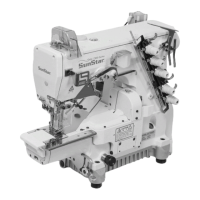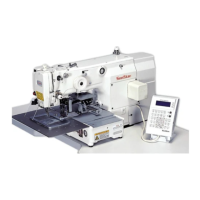21
Stitch Length (mm) Max. Normal Differential Ratio Max. Reverse Differential Ratio
3.6 1 : 1.1 1 : 0.7
2.5 1 : 1.6 1 : 0.7
2.0 1 : 1.8 1 : 0.7
1.4 1 : 2 1 : 0.7
8) Adjustment of differential feed
[ Warning ]
Be sure to turn the power switch off before adjusting differential feed.
[ Figure 25 ]
①
②
③
③
④
④
(1) Normal Differential Feed (Shrink Sewing)
Loosen [the differential lever adjusting nut①]. Move
[the differential feed lever②] up or down to place it at
the desired position, and fasten [the nut①].
When the lever is set at [Graduation (Long) (C)], the
ratio of main feed to differential feed becomes 1:1.
When [the lever②] is set at the position higher than
Graduation C, the lever is in the normal differential feed
mode. The graduations located above Graduation C refer
to 1:1.25, 1:1.15, 1:1.75 and 1:2 from the bottom.
[ Figure 26 ]
(2) Reverse Differential Feed (Stretch Sewing)
When [the differential feed lever②] is set at the place
below [Graduation (Long)③], it is in the reverse
differential feed mode. When the lever is set at
[Graduation S], the ratio of main feed to differential feed
becomes 1:0.7.
(3) Adjustment of Differential Feed During Operation
When differential ratio needs to be adjusted during sewing, connect the lever to the chain.
To adjust the maximum or minimum limits of the differential feed lever, use [the differential feed lever stoppers (2EA)④].
※ Depending on the stitch length, the scope of differential ratios is different. Please see the table below

